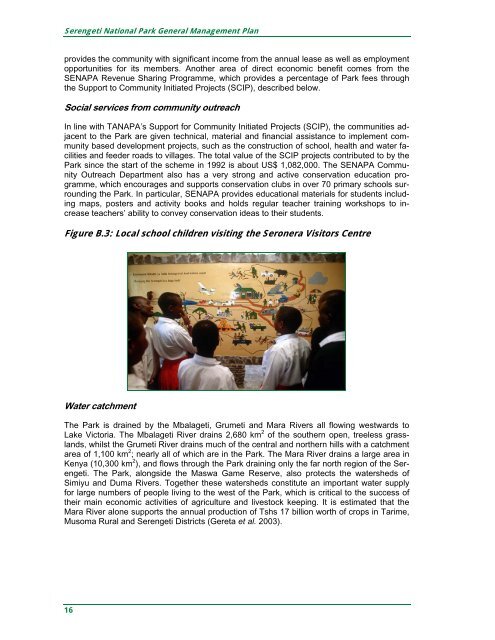Serengeti General Management Plan
Serengeti General Management Plan
Serengeti General Management Plan
- TAGS
- serengeti
- www.zgf.de
You also want an ePaper? Increase the reach of your titles
YUMPU automatically turns print PDFs into web optimized ePapers that Google loves.
<strong>Serengeti</strong> National Park <strong>General</strong> <strong>Management</strong> <strong>Plan</strong><br />
provides the community with significant income from the annual lease as well as employment<br />
opportunities for its members. Another area of direct economic benefit comes from the<br />
SENAPA Revenue Sharing Programme, which provides a percentage of Park fees through<br />
the Support to Community Initiated Projects (SCIP), described below.<br />
Social services from community outreach<br />
In line with TANAPA’s Support for Community Initiated Projects (SCIP), the communities adjacent<br />
to the Park are given technical, material and financial assistance to implement community<br />
based development projects, such as the construction of school, health and water facilities<br />
and feeder roads to villages. The total value of the SCIP projects contributed to by the<br />
Park since the start of the scheme in 1992 is about US$ 1,082,000. The SENAPA Community<br />
Outreach Department also has a very strong and active conservation education programme,<br />
which encourages and supports conservation clubs in over 70 primary schools surrounding<br />
the Park. In particular, SENAPA provides educational materials for students including<br />
maps, posters and activity books and holds regular teacher training workshops to increase<br />
teachers’ ability to convey conservation ideas to their students.<br />
Figure B.3: Local school children visiting the Seronera Visitors Centre<br />
Water catchment<br />
The Park is drained by the Mbalageti, Grumeti and Mara Rivers all flowing westwards to<br />
Lake Victoria. The Mbalageti River drains 2,680 km 2 of the southern open, treeless grasslands,<br />
whilst the Grumeti River drains much of the central and northern hills with a catchment<br />
area of 1,100 km 2 ; nearly all of which are in the Park. The Mara River drains a large area in<br />
Kenya (10,300 km 2 ), and flows through the Park draining only the far north region of the <strong>Serengeti</strong>.<br />
The Park, alongside the Maswa Game Reserve, also protects the watersheds of<br />
Simiyu and Duma Rivers. Together these watersheds constitute an important water supply<br />
for large numbers of people living to the west of the Park, which is critical to the success of<br />
their main economic activities of agriculture and livestock keeping. It is estimated that the<br />
Mara River alone supports the annual production of Tshs 17 billion worth of crops in Tarime,<br />
Musoma Rural and <strong>Serengeti</strong> Districts (Gereta et al. 2003).<br />
16
















